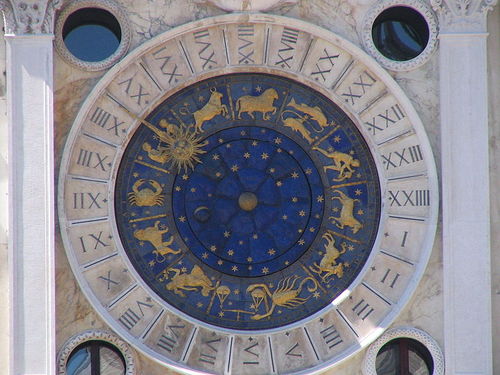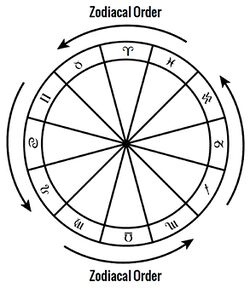Zodiac Sign

Signs of the zodiac are one of the most important concepts in astrology.
They are 30-degree segments of the 360-degree circle that is the horoscope, each named for a constellation.
Etymology
The English term “sign” is derived from the Latin word “signum”, which itself was used as a translation of zōidion in the Roman period. Zoidion is the original name for a “sign” of the zodiac in Greek. Zōidion (ζῴδιον) is the singular, meaning “sign”, and zōidia (ζῴδια) is the plural, meaning “signs”.[2]
The Difference between Signs and Constellations
Ancient star-gazers in Mesopotamia recognized that the sun and moon traveled along a predictable belt, from east to west. The constellations along this pathway gained special importance. With names like the lion, the crab, the bull, and the sea-goat, the apparent zoological nature of most of these constellations gave rise to their name, the zodiac. During the 6th century BCE the Babylonians decided to use twelve 30-degree segments of the heavens that roughly coincided with the zodiacal constellations. They were very concerned to track planetary movements and eclipses, and the 30-degree segments along the ecliptic offered them greater precision. These segments are the zodiacal signs.
It should be noted, however, that some of the zodiacal constellations (like Aries) barely touch the ecliptic; and a small section of the constellation Ophiuchus passes through it. Some of the constellations (like Cancer) occupy much less than 30 degrees along the ecliptic, whereas Virgo takes up 47 degrees along the sun's pathway. So the sign-constellation correspondence has always been only approximate.
The sign names still coincide with the constellations for which they were named: a constellation and sign are both called Aries, for example. This duplication was sensible thousands of years ago when signs and their namesake constellations were roughly in the same sectors of the heavens. The Babylonians used a sidereal zodiac, as Hindu astrologers do today. With the precession of the equinoxes their signs and constellations still overlap because they are pegged to the motion of fixed stars. With the tropical zodiac used in western astrology, calibrated to the solar seasonal cycle, signs and their namesake constellations have moved considerably apart over the centuries. Zero degrees Aries marks the spring equinox in the western tropical zodiac, for example, but the sign of Aries is now in a part of the heavens roughly 27 degrees previous to the Aries sidereal sign and constellation, due to precession. Western astrologers live comfortably with both a sign and constellational Aries, but non-astrologers sometimes find the two definitions confusing.
The passing of the signs through the year is really a type of calendar, with each zodiacal "month" being approximately 30 days long. The sun's movement roughly equates to one degree per day. In the tropical zodiac zero degrees Aries begins in March with the spring equinox, followed by Cancer in June at the summer solstice. Libra begins around September 21 at the autumn equinox, with Capricorn in December at the winter solstice.
Using the Signs in Astrology
Most people know their astrological "sign" as their sun sign, or sign the sun was in at their birth. Each planet and sensitive point also has its own astrological sign, depending upon their position in the sky at the time of birth. Each planet in a sign also has its own degree within the 30-degree sign.
Each sign is classified according to its element or triplicity: earth, air, fire, and water; as well as its order in each quarter of the horoscope (Quality or Quadruplicities.) Each sign also has one or two planets that "rule" it and supposedly have a special affinity for it. A planet is strengthened if it is located within the sign it rules (Domicile.) For example, Aries is ruled by Mars; and Aquarius is ruled by Saturn (traditional) and Uranus (modern.) Signs are often related to personality-types and character traits, based upon their element, quality, and ruling planet's attributes. These are described in the articles for each sign. The constellations still seem to shed some light on the signs named for them, as well. Since the lion is the king of beasts and an emblem of royalty, sun-sign Leos are supposedly proud people who enjoy leadership roles.
Signs indicate "how" or "in what manner" a planet operates. As such, they give important clues to the individual's personality; but they are not the only horoscope feature that astrologers examine.
Under the influence of "evolutionary" astrologers like Dane Rudhyar some astrologers rank-order the spiritual maturity of signs according to their order in the zodiac. Supposedly Aries is the most primitive, relying on aggression and instinct; while Pisces symbolizes the spiritually mature soul. In reality, humans are not so easily type-cast by their sun-signs.
Bibliography
- Skye Alexander, 1988. Planets in Signs, Whitford Press
- Francesca Rochberg, 2004. The Heavenly Writing: Divination, Horoscopy, and Mesopotamian Culture, Cambridge University Press
- Dane Rudhyar, 1978. An Astrological Triptych: The Illumined Road, rev. ed., Aurora Press
Notes and References
- ↑ From the church of St. Mark in Venice
- ↑ 2.0 2.1 From The Astrology Dictionary of Chris Brennan
- ↑ This is the order in which the planets usually move through the signs.
- ↑ The only times when this is not true is when a planet turns retrograde, at which point it begins to move clockwise.
